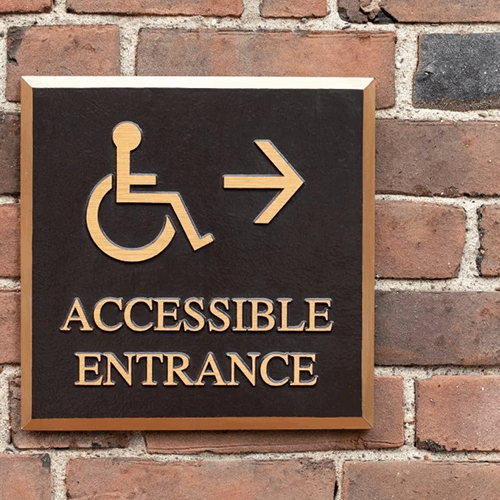
The Americans With Disabilities Act (ADA) in 1990 changed how public spaces and businesses operate. These federal laws require every business to show a commitment to include those with disabilities. Your commercial space must follow all the regulations, including your entryway doors.
Failure to comply with these regulations will result in substantial fines, starting at $75,000 and increasing to $150,000. To avoid these fines and potential lawsuits, you'll want to take every step possible to ensure your entryway doors meet or exceed ADA standards.
The Americans With Disabilities Act (ADA) is a civil rights law that outlaws discrimination against anyone with a disability. This includes all areas, such as:
This law aims to ensure people with disabilities have the same rights and opportunities as all other individuals.
The ADA is divided into five sections, or titles, that relate to various areas of accessibility. Title III covers public accommodations and prohibits establishments from discriminating against patrons with disabilities. Public accommodations refer to the following:
Title III also requires these businesses to take necessary steps to communicate with individuals with vision, hearing, and speech disabilities. Your entryway doors should meet the following minimum standards to comply with Title III of the ADA.
Your commercial entryway doors must provide easy access to individuals using a wheelchair. The minimum width per ADA regulations is 36 inches, and the door must open to a 90-degree angle. Entries must have a clearance of 36 inches or 54 inches if the doors are near the end of the hallway.
Any double doors that open in opposing directions must have the ability to open at least 48 inches wide. The threshold must be less than half an inch, except for outer sliding doors. These may have up to a 3/4-inch entry point.
Some door handles can be challenging for people with disabilities to open. A round door knob requires a twisting motion that some people do not have the mobility for. Regulations for your door handles state that they cannot use pinching or twisting motions to open.
Door handles must be easy for disabled individuals to open with one hand. Using a lever handle makes it easier to push, helping those with disabilities but also anyone who may have their hands full.
Looped door handles are another option that does not require twisting or turning. Instead, you push or pull the loop to open the door.
The ADA requires doors with a closer to take a minimum of 5 seconds to close from a 90-degree to 12-degree position. This range is commonly referred to as the closing sweep.
Doors containing spring hinges should take a minimum of 1.5 seconds to move from the open position to a 70-degree angle. These regulations ensure everyone has enough time to safely pass through an entryway.
Regulations in Title III state that swinging door surfaces within 10 vertical inches of the floor must have a smooth surface on the push side, covering the entire width of the door. This prevents mobility assistance devices, like canes and wheelchairs, from getting caught on anything.
You can have a kick plate installed, but any holes or gaps must be covered. Sliding doors and tempered glass doors are excluded from this rule.
Every entrance on the outside of your building must have a ramp and a corresponding accessible path. The path must provide direct access to public sidewalks and into the street. This path must continue to accessible parking zones, loading areas, or public transit to comply.
Although door automation isn't a requirement, it is recommended because it resolves several compliance issues. For example, you don't have to worry about door handle type, clearance, or push force. You can use automatic doors in conjunction with non-ADA-compliant doors to provide multiple entrances into your business.
Contact CDF Distributors for your ADA-compliant entryways. We'll get your doors delivered fast so that you maintain your ADA compliance.